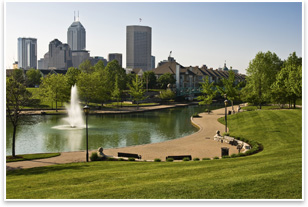|
Sustainable Design Assessment Explores a Redevelopment District for Indianapolis
by Russell Boniface
Associate Editor
How do you . . . redevelop a district within a city?
Summary: The AIA Communities by Design Sustainable Design Assessment Team (SDAT) is reviewing the SDAT Indianapolis application for creating a sustainable district within the city.

The SDAT will focus on neighborhood revitalization with light rail as a component.
The SDAT Indianapolis proposal, “Indianapolis Smart Growth Redevelopment District,” calls for sustainable redevelopment in one area of the city.
SDAT will make a preliminary visit to Indianapolis this month and a full team visit in the fall. The SDAT follow-up and final report is expected January 2010.
The SDAT team will work with the Ball State University College of Architecture and Planning and the Indianapolis Project School on the proposed project. The Ball State University College of Architecture and Planning is an integral partner in this SDAT proposal. During the fall 2008 and spring 2009 semesters, students provided background studies related to the proposed light rail stations.
Barriers to success
The study area is dominated by abandoned industrial sites and more than 70 brownfields along an abandoned rail corridor. There is a decaying neighborhood with no major streets. There are vacant lots, and illegal dumping is rampant. The area has remained out of sight for decades.
The community began re-evaluation with the completion of the popular Monon Trail in the early 2000s, the opening of a new charter school in 2008, neighborhood redevelopment strategies to the south and west, and the identification of light rail site.

The study area is dominated by abandoned industrial sites and more than 70 brownfields along an abandoned rail corridor.
The former commercial and industrial sites, however, have left contaminants in the soil and ground water. These environmental conditions present a challenge to commercial, industrial, and residential redevelopment, the SDAT proposal shows. The city’s Brownfields Program has brought resources into the area, with six assessment and remediation projects currently under way and two significant ones completed nearby. In addition, much of the central core of Indianapolis is plagued with a sewer system that outfalls into creeks when stormwater runoff fills the pipes.
The cost of implementing the proposal could be a challenge, according to the proposal. Public financing faces a variety of challenges in Indianapolis, including a current property tax revolt that would make it difficult for local governments to engineer large-scale redevelopment projects. Citizens Energy Group, however, has committed to underwrite the entire local cost, committing up to $15,000 toward the SDAT process.
The SDAT Indianapolis proposal has its roots in a recommendation by the Indianapolis Green Commission. The SDAT creates a vision plan addressing the issues, followed by a master plan demonstrating how this vision can be implemented. |




